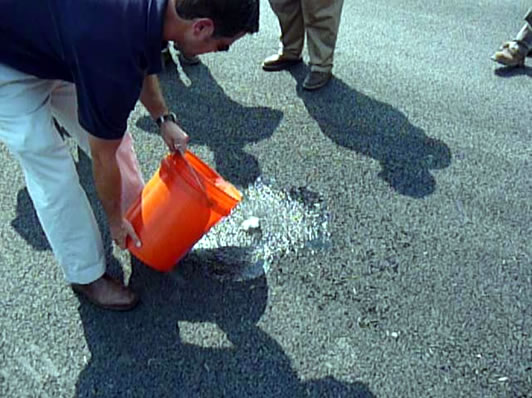In Virginia, most asphalt concrete (AC) is produced using specifications established by the Virginia Department of Transportation (VDOT). AC mixes are divided into several categories – surface mixes, intermediate mixes, base mixes, and drainage layer mixes. Within each category, one or more actual mixes may be specified. The mixes in each category will vary based on the size of aggregate in the composition as well as the asphalt cement (liquid asphalt) or binder used.
T oday, VDOT has three common families for their mixes – dense graded asphalt, gap-graded (stone matrix asphalt), and open-graded asphalt. Dense graded asphalt mixes are sometimes referred to as SUPERPAVE™ mixes. These mixes are the most commonly used in Virginia’s pavements.
oday, VDOT has three common families for their mixes – dense graded asphalt, gap-graded (stone matrix asphalt), and open-graded asphalt. Dense graded asphalt mixes are sometimes referred to as SUPERPAVE™ mixes. These mixes are the most commonly used in Virginia’s pavements.
 Gap-graded (stone matrix asphalt (SMA)) is a type of mix usually reserved for high-traffic and truck volumes on interstates and primary roads. These mixes generally cost more due to the strict aggregate requirements, higher asphalt cement contents, and the specialized asphalt plant equipment required. However, the increased cost is offset by the increased service life and reduced user costs. These mixes have been used in urban areas and facilities with heavy, slow moving traffic – but care must be taken to ensure the mixes are produced and placed properly. Being a specialty mix, proper planning and coordination with the local asphalt contractor community is crucial.
Gap-graded (stone matrix asphalt (SMA)) is a type of mix usually reserved for high-traffic and truck volumes on interstates and primary roads. These mixes generally cost more due to the strict aggregate requirements, higher asphalt cement contents, and the specialized asphalt plant equipment required. However, the increased cost is offset by the increased service life and reduced user costs. These mixes have been used in urban areas and facilities with heavy, slow moving traffic – but care must be taken to ensure the mixes are produced and placed properly. Being a specialty mix, proper planning and coordination with the local asphalt contractor community is crucial.
 Open-graded asphalt has two purposes in Virginia. First, open-graded asphalt drainage layers (OGDL) are used under new pavements to promote drainage and reduce/eliminate the damage from trapped water. OGDL has been used under the pavement at Richmond International Raceway as well as the under the turf at Virginia Tech’s Lane Stadium. Second, these mixes called porous friction course (PFC) can be used to reduce the noise on certain highways. With the reduction in noise is a reduction of splash and spray, particularly at night. When these mixes are used together and combined with an aggregate layer, then a permeable pavement is constructed (See Permeable Parking Lots.)
Open-graded asphalt has two purposes in Virginia. First, open-graded asphalt drainage layers (OGDL) are used under new pavements to promote drainage and reduce/eliminate the damage from trapped water. OGDL has been used under the pavement at Richmond International Raceway as well as the under the turf at Virginia Tech’s Lane Stadium. Second, these mixes called porous friction course (PFC) can be used to reduce the noise on certain highways. With the reduction in noise is a reduction of splash and spray, particularly at night. When these mixes are used together and combined with an aggregate layer, then a permeable pavement is constructed (See Permeable Parking Lots.)
The table below contains the most common VDOT mixes by family and where they are used. The specifications for these mixes can be found at the VDOT website – www.virginiadot.org.
| Category | AC Mix Name | Typical Uses |
| Dense Graded or SUPERPAVE™ Mixes | ||
| Surface | SM-4.75 | Recreational uses, parking lots, driveways, subdivisions, lower volume roadways |
| SM-9.0 | Recreational uses, parking lots, driveways, subdivisions, lower volume roadways | |
| SM-9.5 | Subdivision, streets, and roadways | |
| SM-12.5 | Subdivision, streets, and roadways | |
| Intermediate | IM-19.0 | Subdivision, streets, and roadways |
| Base | BM-25.0 | Subdivision, streets, and roadways |
| Gap-Graded or SMA Mixes | ||
| Surface | SMA-9.5 | Interstates and Primary Routes, traffic volumes greater than 10,000 ADT |
| SMA-12.5 | Interstates and Primary Routes, traffic volumes greater than 10,000 ADT | |
| Intermediate | SMA-19.0 | Interstates and Primary Routes, traffic volumes greater than 20,000 ADT |
| Open Graded Mixes | ||
| Surface | PAM-9.5 | Permeable pavements and parking lots |
| PFC-9.5 | Consult the VAA Office for Uses | |
| PFC-12.5 | Consult the VAA Office for Uses | |
| Base | PAM-19.0 | Permeable pavements and parking lots |
| OGDL | New construction projects | |
Unless designated in a VDOT specification, most mixes will use a PG 64-22 asphalt cement binder. However, many of the mixes identified in the table can be modified by changing the asphalt cement. Stiffer asphalt cement can be used in higher stress applications such as intersections, bus stops, and industrial facilities. A stiff, but flexible asphalt cement is generally incorporated when AC is laid over existing Portland Cement Concrete pavements to reduce reflective cracking.
Specific questions on the type or types of AC mixes to use on a project should be directed to the VAA Office or your local VDOT District Materials Engineer. A list of the VDOT District Materials Engineers can be found at http://www.virginiadot.org/business/materials-default.asp.
Related Links
- Dense-Graded
http://www.pavementinteractive.org/article/dense-graded-hma/ - Stone Matrix Asphalt
http://www.pavementinteractive.org/article/stone-matrix-asphalt/ - Open-Graded
http://www.pavementinteractive.org/article/open-graded-hma/ - Superpave Method
http://www.pavementinteractive.org/article/mix-designsuperpave-method/